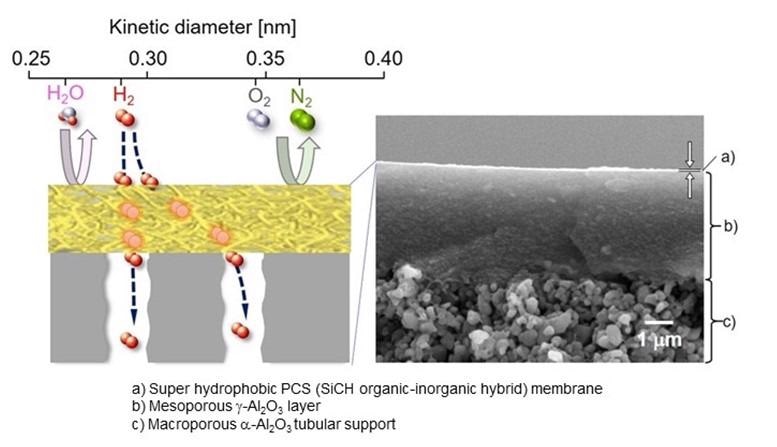Mar 9 2021
There are various reasons for praising hydrogen as the 'fuel of the future.' Firstly, in contrast to the hydrocarbons that are traditionally used, hydrogen offers a higher energy yield.
 A cross-sectional image of selective hydrogen gas permeation in a super hydrophobic membrane formed on a porous tubular support. Image Credit: Yuji Iwamoto from Nagoya Institute of Technology.
A cross-sectional image of selective hydrogen gas permeation in a super hydrophobic membrane formed on a porous tubular support. Image Credit: Yuji Iwamoto from Nagoya Institute of Technology.
Secondly, if hydrogen fuel is used commercially, the imminent global warming crisis can be mitigated by decreasing the use of polluting and exhaustible fossil fuels. This is because hydrogen fuel produces just water as the byproduct. Hence, the focus of current studies has been on eco-friendly and efficient methods to generate hydrogen fuel.
Solar hydrogen production via photoelectrochemical (PEC) water-splitting reaction is a valuable 'green' technique for hydrogen fuel production. This is because of its cost-effectiveness, low operating temperatures and high conversion efficiency.
But efficient isolation of hydrogen gas from a mixture of gases (known as 'syngas') under various kinds of environmental conditions has been difficult. A study published recently in the Separation and Purification Technology journal endeavors to overcome this challenge.
In the study, a research group from Nagoya Institute of Technology, Japan, headed by Professor Yuji Iwamoto, together with scientists from France, has been successful in characterizing a novel membrane that enables highly selective separation of hydrogen gas produced from the PEC reaction.
Membrane separation is attractive as a low-cost hydrogen gas purification technology. However, current techniques face several challenges, for example, water-induced swelling with polymer membranes and lower hydrogen permeance with metal, polymer, and supported liquid membranes.
Yuji Iwamoto, Professor, Nagoya Institute of Technology
Initially, the team developed an organic-inorganic hybrid polymeric membrane, mainly comprising of a polymer known as 'polycarbosilane' (PCS) formed on aluminum oxide (Al2O3)-based porous support.
By using high-molecular-weight PCSs with a melting point above 200°C, we showed that a superhydrophobic PCS membrane could be deposited on a mesoporous γ-Al2O3-modified macroporous α-Al2O3 tubular support.
Yuji Iwamoto, Professor, Nagoya Institute of Technology
Following the successful development of the PCS membrane, the team tested it under PEC reaction conditions.
As proposed, the PCS membrane exhibited high hydrophobicity. Furthermore, the PCS membrane showed superior hydrogen selectivity under the flow of a simulated highly humid gas mixture at 50°C.
More analyses showed that the preferential hydrogen permeation via the PCS membrane was regulated by the 'solid state diffusion' mechanism.
On the whole, regardless of the ambient environmental conditions, the PCS membrane was highly efficient at isolating hydrogen gas.
The development and characterization of the new PCS membrane will enable the commercial adoption of the membrane to not just allow the use of hydrogen fuel for energy requirements but also restrict the use of non-renewable fossil fuels.
With this technological development, we expect great progress in environmental-friendly and sustainable hydrogen production.
Yuji Iwamoto, Professor, Nagoya Institute of Technology
Hopefully, the use of PCS membrane will pave a path toward a hydrogen-based society.
Journal Reference:
Kubo, M., et al. (2021) Superhydrophobic polycarbosilane membranes for purification of solar hydrogen. Separation and Purification Technology. doi.org/10.1016/j.seppur.2020.117998.